Virgin Islands, United States, are a group of small islands east of Puerto Rico and west of the British Virgin Islands. They lie in the Caribbean Sea, which is part of the Atlantic Ocean. St. Croix, St. John, and St. Thomas islands, as well as many nearby islets, make up the U.S. Virgin Islands. They are a territory of the United States and the easternmost U.S. possession.
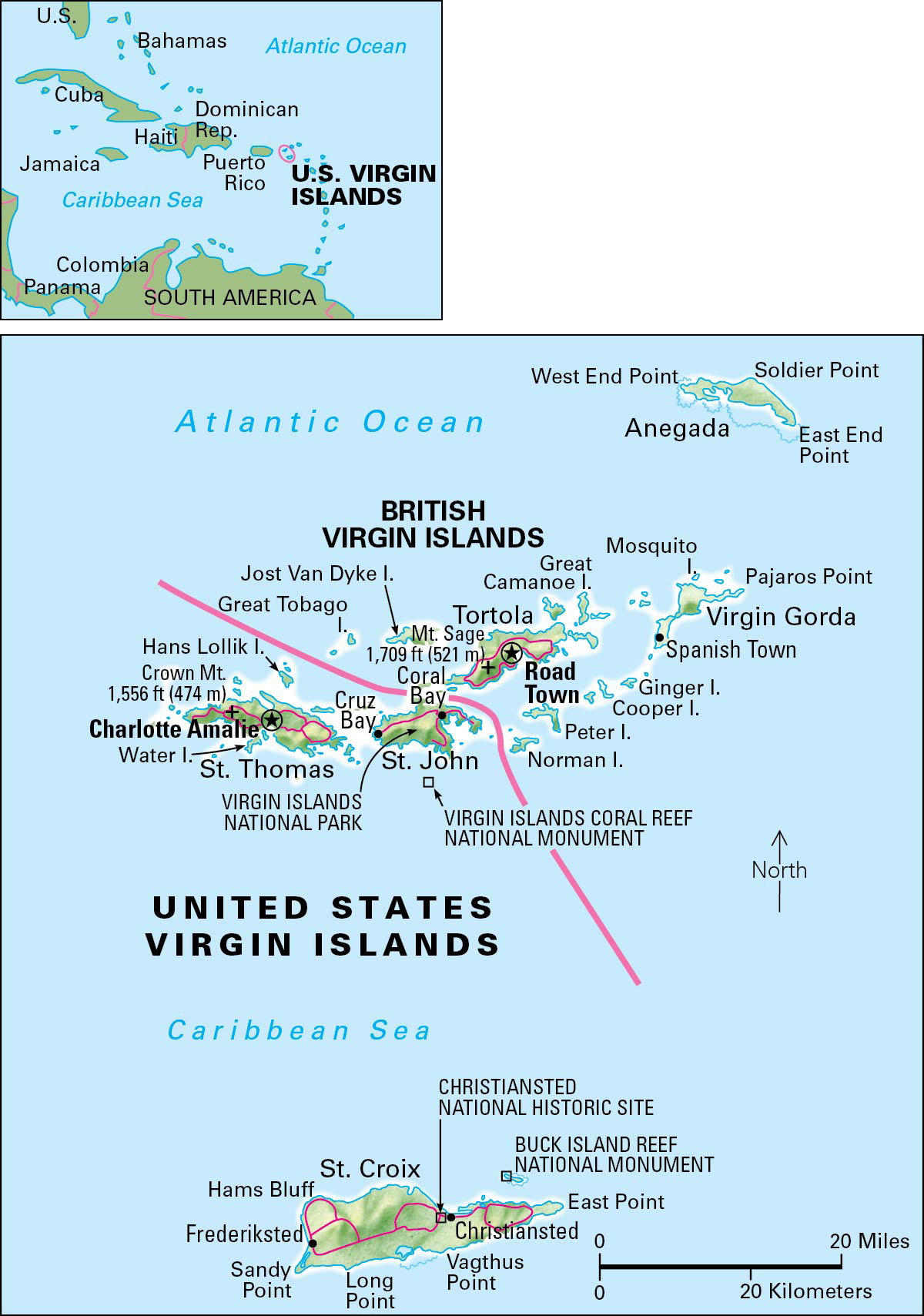
The U.S. Virgin Islands have a mild, subtropical climate, and tourism dominates their economy. A few good harbors make the territory an important center of trade. Refined petroleum products are the islands’ chief exports. Except for St. Croix, the Virgin Islands are rugged and hilly. Agriculture is limited, and the islanders must import much of their food.
Virgin Islanders are mainly of African descent. Many are descendants of slaves who worked on plantations in colonial times. About half the people are native-born. Immigrants include people from other Caribbean islands, Americans from the continental United States, and Puerto Ricans.
The Italian explorer Christopher Columbus sighted the islands in 1493. Their fresh beauty and untouched appearance charmed him. Columbus named them the Virgin Islands in honor of Saint Ursula, a British Christian of the A.D. 300’s or 400’s. According to legend, an Asian people called the Huns, because they opposed Christianity, killed Ursula and 11,000 other young women traveling with her. Columbus claimed the islands for Spain, but the Spanish did not settle there. About 1672, Denmark established a permanent settlement on St. Thomas. The Danes took possession of St. John in 1717 and bought St. Croix from France in 1733. Danish colonists developed a profitable sugar industry that supported the islands’ growth. In 1917, the United States purchased the islands from Denmark. Today, they are a popular travel destination.
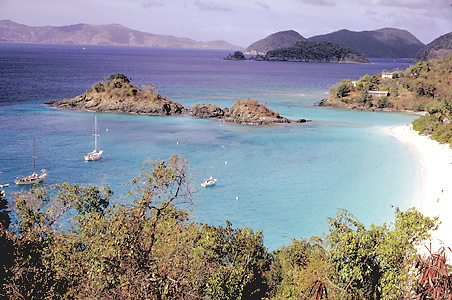
Government
The Virgin Islands are an unincorporated territory of the United States—that is, an area under U.S. jurisdiction where Congress has determined that not all provisions of the U.S. Constitution apply. For example, Virgin Islanders hold U.S. citizenship. However, they may not vote in U.S. presidential elections.
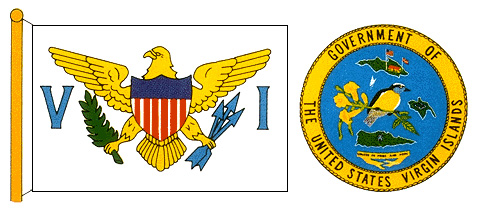
The Revised Organic Act of the Virgin Islands, passed by the U.S. Congress in 1954, provides for the government of the territory. The president of the United States serves as chief of state of the Virgin Islands. A governor and lieutenant governor elected by Virgin Islanders for four-year terms head the local government. They may serve up to two consecutive terms.
The territory has a unicameral (one-house) legislature, which consists of a 15-member Senate. The people elect the senators to two-year terms. The governor may veto any bills. The governor can also apply a line-item veto on funding measures, rejecting individual items in a bill without vetoing the whole bill. A two-thirds majority of the Senate may override either type of veto. The Senate meets at Charlotte Amalie, the territorial capital. The islands have three major political parties—the Democratic Party, the Independent Citizens Movement, and the Republican Party.
The U.S. Federal District Court of the Virgin Islands hears federal cases. The president of the United States appoints its judges with the advice and consent of the U.S. Senate. The Superior Court of the Virgin Islands handles local affairs. The Supreme Court of the Virgin Islands hears appeals of decisions made by the Superior Court. The governor appoints judges to both the Superior Court and the Supreme Court.
All residents who are 18 years of age or older and are U.S. citizens may vote in local elections. The residents elect a delegate to the U.S. House of Representatives for a two-year term. The delegate has voting powers only in House committees, not in the full House.
People
Population and ancestry.
About 75 percent of Virgin Islanders are black people of African descent, and nearly 15 percent are white. The rest are of mixed ancestry or belong to other population groups. Nearly half of all islanders were born in the Virgin Islands. Most other residents moved to the islands from other Caribbean islands, the continental United States, and Puerto Rico.
The official language is English. On St. Croix, many people speak Spanish. Some people also speak Creole, a dialect that combines West African grammar and speech patterns with colonial Danish, Dutch, English, and French.
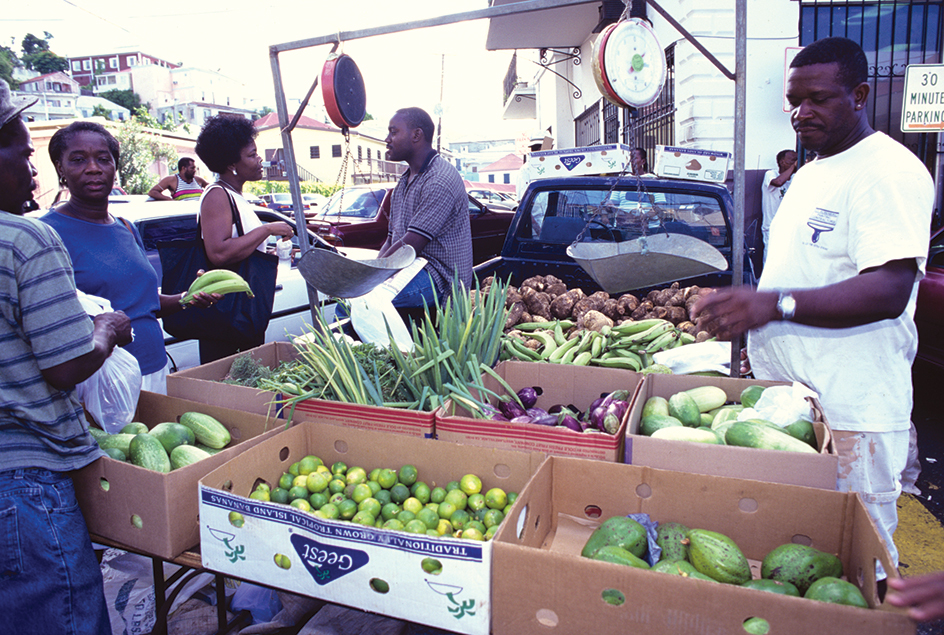
Religion.
A majority of Virgin Islanders are Protestants, especially Baptists. About one-third of the people, many of whom are immigrants from the Dominican Republic and Puerto Rico, are Roman Catholics. Some islanders also practice obeah, a traditional African religion with elements of sorcery and witchcraft.
Food.
Cooking in the Virgin Islands reflects a mixture of African, Asian, European, and indigenous (native) influences. Virgin Islanders eat many soups and stews, including callaloo (also spelled kallaloo), a soup made with the leaves of the taro plant. Many meats are barbecued with tangy spices or made into a spicy stew called curry. Islanders eat a variety of local fish as well. Johnnycakes are a popular traditional type of deep-fried bread. Root vegetables provide much of the starch in islanders’ diets, as does fungi << FOON gee >>, a dish made from cooked cornmeal.
Clothing and architecture.
Virgin Islanders wear clothing much like that worn elsewhere in North and South America. In general, they dress modestly when out in public.
The cities of Charlotte Amalie and Christiansted have many examples of traditional Caribbean architecture from the 1700’s. Many houses there are two or three stories tall and have exterior staircases, window shutters, and low roofs with sloping ends and sides. The houses are built of brick, rubble (coarse pieces of stone and coral), and wood, and often have pastel exteriors. The city of Frederiksted has many Victorian-style buildings from the 1800’s.
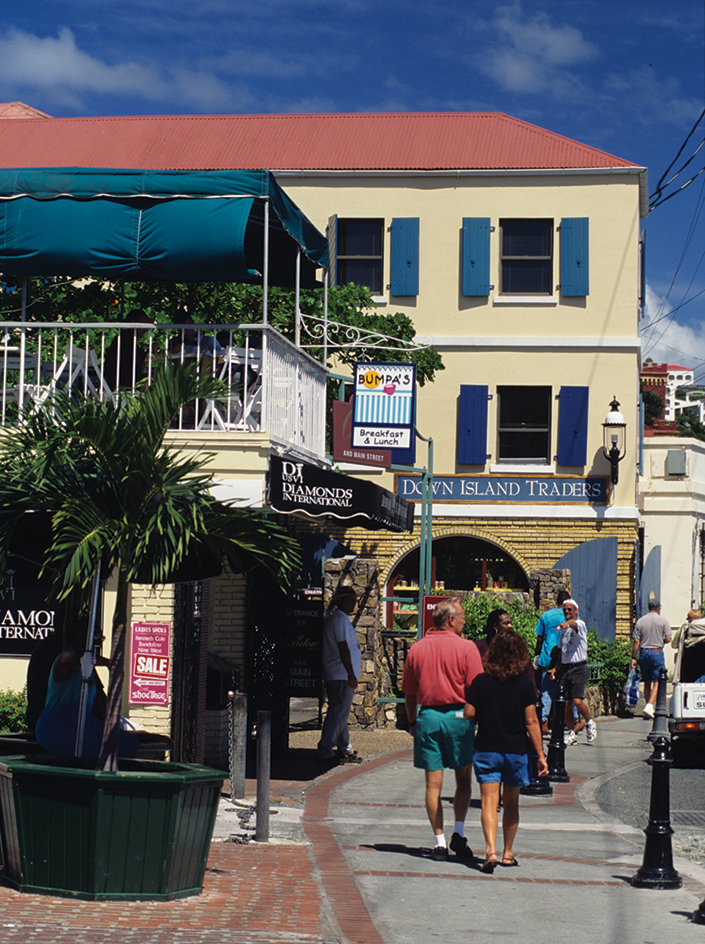
Education.
The Virgin Islands’ public school system provides free education from kindergarten through high school. A commissioner of education and a nine-member board of education supervise the system. Board members are elected to four-year terms. Children must start kindergarten during the year when they turn 5 and attend school until the end of the school year closest to their 16th birthday. The University of the Virgin Islands is the only accredited institution of higher education in the islands. It has campuses on St. Thomas and St. Croix.
Land and climate
Location.
The United States Virgin Islands lie about 40 miles (64 kilometers) east of Puerto Rico, just west of the British Virgin Islands. The island group forms the westernmost part of a chain of Caribbean islands called the Lesser Antilles (see West Indies). Miami, Florida, lies about 1,100 miles (1,770 kilometers) to the northwest, and Panama is about 1,200 miles (1,930 kilometers) to the southwest. The U.S. Virgin Islands have a general coastline of 117 miles (188 kilometers) and a tidal shoreline, including bays, creeks, offshore islands, rivers, and sounds, of 175 miles (282 kilometers).
Islands.
All of the U.S. Virgin Islands except St. Croix are rugged and hilly. St. Croix has less mountainous terrain. The islands have many bays and inlets that shelter a variety of animal and plant life. Tropical flowers and trees flourish, including bougainvillea, poinciana (also known as flame trees), and hibiscus. Fossils of ancient animals show that the sea once covered the islands. The composition of the rocks that form much of the land suggests that volcanoes pushed the islands up from the ocean floor. Only St. Croix, St. John, St. Thomas, and Water Island have permanent populations.
Saint Croix
(pop. 41,004) is the largest of the islands. It lies about 40 miles (64 kilometers) south of St. Thomas. St. Croix covers 82 square miles (212 square kilometers) and makes up about two-thirds of the island group’s land mass. Christiansted (pop. 2,637) is St. Croix’s local government center. Frederiksted (pop. 732) is a center for trade. People also live in small towns and on estates throughout the island.
St. John
(pop. 3,881) lies 2 miles (3 kilometers) east of St. Thomas and less than 1 mile (1.6 kilometers) from British Tortola. It covers 19 square miles (49 square kilometers). The Virgin Islands National Park takes up about two-thirds of the island (see Virgin Islands National Park). The majority of islanders live in the Cruz Bay community. There is also a large tourist development at Caneel Bay. Many islanders live on small plots of land and raise their own produce and poultry.
St. Thomas
(pop. 42,097) covers 27 square miles (70 square kilometers). Its central range of hills offers lovely ocean views. Crown Mountain, the islands’ highest point, rises 1,556 feet (474 meters) above sea level. Charlotte Amalie (pop. 8,194), the territorial capital, is the largest town in the Virgin Islands. Its excellent harbor makes it the islands’ chief center of trade. The harbor is also a popular destination for cruise ships.
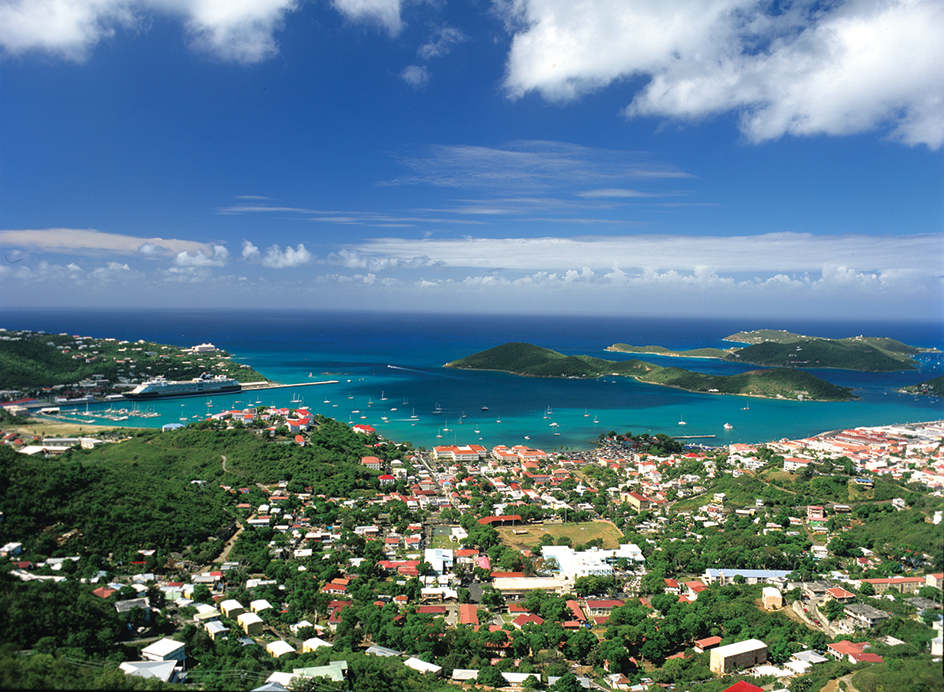
Water Island
(pop. 164) covers less than 1 square mile (2.6 square kilometers). It lies southwest of Hassel Island, at the outer edge of St. Thomas Harbor. During World War II (1939-1945), the U.S. government began construction of fortifications, including underground bunkers, on the island. For several years after the war, the United States used Water Island to test chemical weapons. Today, most buildings on the island are private homes.
Climate.
The Virgin Islands have a delightful subtropical climate all year long. Steady breezes called trade winds blow most of the year, and there are no extremes of heat or cold. The temperature ranges from 70 to 90 °F (21 to 32 °C) and averages 80 °F (27 °C). The islands receive from 40 to 60 inches (100 to 150 centimeters) of rainfall a year. The amount of rainfall varies widely from island to island, and higher elevations may get from 50 to 60 inches (130 to 150 centimeters) a year. The heaviest showers generally occur from September to November.
Economy
Services, mainly those related to tourism, employ a majority of the Virgin Islands’ work force. The territorial government employs many people. Construction and manufacturing are other important sectors of the economy. The islands are not suited to large-scale farming, and islanders must import most of their food. The United States is the islands’ chief trading partner.
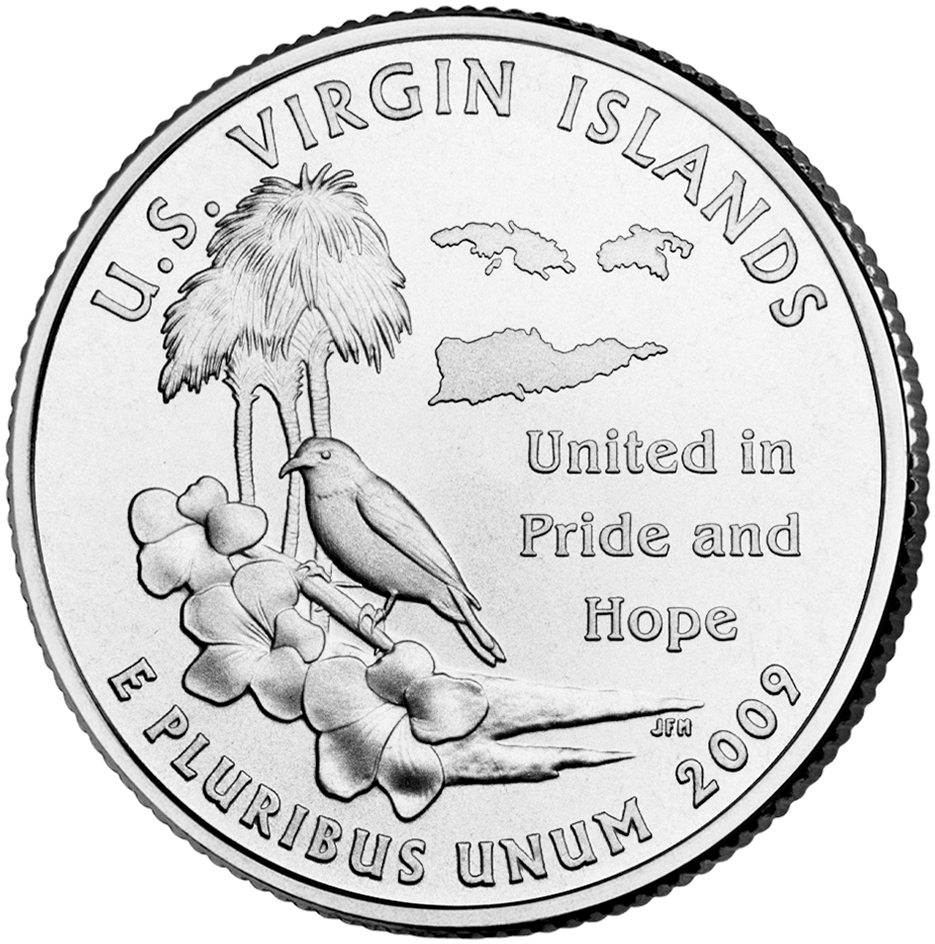
Tourism
is the U.S. Virgin Islands’ chief industry. It accounts for much of the islands’ gross domestic product—that is, the total value of goods and services produced in the islands in one year. Cruise ship passengers and other tourists visit the islands to enjoy the pleasant climate, excellent beaches, and lovely scenery. Historic buildings and plantations, the Virgin Islands National Park, and coral reefs attract many visitors. Most visitors come from the United States. A carnival held every spring on St. Thomas is a popular event.
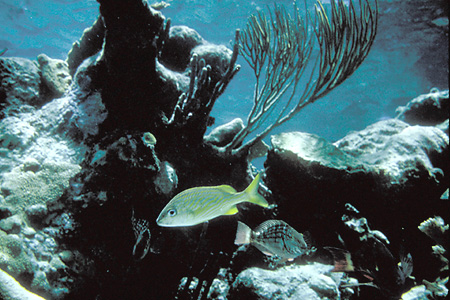
Manufacturing.
Most of the U.S. Virgin Islands’ manufactured products are made in St. Croix. Factories on the islands produce electronics, pharmaceuticals (medicinal drugs), and rum. The distillation of rum, made from sugar cane, is one of the Virgin Islands’ oldest industries. For many years, one of the world’s largest petroleum refineries operated on St. Croix. The refinery was closed in 2012.
Agriculture and mining.
Less than 1 percent of Virgin Islanders are farmers. Beef and dairy cattle are the leading agricultural products. Islanders also raise chickens, goats, pigs, and sheep. Leading crops include bananas, coconuts, mangoes, and other fruits; cucumbers, eggplants, and other vegetables; and sugar cane. Most farming occurs on St. Croix.
Transportation.
Airlines carry people from all over the world to the U.S. Virgin Islands. Airports on St. Croix and St. Thomas handle commercial flights. Small planes and ferries carry people from one island to another. Hundreds of cruise ships, freighters, and naval vessels dock at the territory’s ports each year. All the inhabited islands have paved roads. As on many other Caribbean islands, motorists drive on the left side of the road.
Communication.
The Virgin Islands Daily News published on St. Thomas, is the chief newspaper of the Virgin Islands. Many islanders use the Internet and cellular telephones. Radio and television stations broadcast on St. Croix and St. Thomas.
History
Exploration.
Several groups of Indians lived in the Virgin Islands before Europeans arrived. They included the Ciboney, Igneri, Taíno, and Carib. Christopher Columbus sighted the Virgin Islands in 1493, on his second voyage to the Americas, and claimed them for Spain. The Carib Indians attacked members of Columbus’s crew at Salt River Bay on St. Croix. During the 1500’s, the Spanish killed many of the Indians or enslaved them and took them to work on other islands. Many other Indians fled to escape the Spanish. All the Indians had died or left the islands by about the time England and the Dutch Republic (now the Netherlands) established settlements in the mid-1600’s.
Early settlement.
The Spanish used the Virgin Islands as a place to hide their treasure ships from pirates but never settled there. During the late 1500’s and the 1600’s, European pirates and privateers (private ships licensed to attack enemy vessels) often visited the islands. In 1607, a group of English travelers stopped at the islands on their way to establish a colony in Jamestown, Virginia. Dutch and English settlers landed on St. Croix in 1625. The Dutch abandoned their colony following quarrels with the English and the murder of their governor in 1645. In 1650, a group of Spaniards from Puerto Rico drove the English from their settlement. By 1651, France had driven the Spaniards from the island. The French controlled St. Croix until 1733, when they sold it to Denmark for $150,000.
Danish rule.
In 1666, Denmark established a settlement on St. Thomas and formally claimed the island. Erik Smit served as the island’s first governor, but his colony failed. The Danes made no successful settlement on St. Thomas until 1672. In 1717, they also settled on St. John. The Danish West Indies— the Caribbean islands of St. Croix, St. John, and St. Thomas—remained under Denmark’s authority during most of the years until 1917.
The Danish West India and Guinea Company, under a royal charter, directed the islands’ commercial development in the late 1600’s and early 1700’s. A plantation system of agriculture developed, and the company imported thousands of slaves from Africa to work the land. Cotton and sugar crops sold to Europe became the basis of the islands’ economic growth. Plantation owners came from several countries, including Denmark, England, the Dutch Republic, and France. In 1724, the company tried to boost trade by allowing St. Thomas to trade directly with countries besides Denmark.
A bloody slave uprising on St. John in 1733 destroyed the island’s economic prospects. The uprising caused Denmark to increase its military authority in the Danish West Indies. In 1754, the islands became a colony of the Danish Crown.
The British occupied the islands from 1801 to 1802 and from 1807 to 1815, during the Napoleonic Wars in Europe. The use of English on the islands increased in the years during and after the second occupation.
Another slave revolt began on St. Croix on July 2, 1848. On July 3, Peter von Scholten, the Danish governor general, proclaimed an end to slavery. Without slavery, efforts to develop the islands proved unsuccessful. The colony became a financial burden to Denmark.
United States rule.
On Aug. 4, 1916, Denmark and the United States signed a treaty transferring control of the Virgin Islands to the United States. The treaty was formally ratified on Jan. 17, 1917. Actual control of the islands passed to the United States on March 31, 1917. The U.S. government paid Denmark $25 million for the islands, or about $295 an acre (0.4 hectare). James H. Oliver served as the territory’s first governor.
In 1927, the U.S. Congress passed a law making the people of the Virgin Islands citizens of the United States. In 1936, islanders who could read and write English received the right to vote in local elections.
During World War II, the Virgin Islands served as a U.S. military outpost. In 1954, the U.S. Congress provided for a territorial legislature in the Virgin Islands. Congress created the Virgin Islands National Park in 1956.
John D. Merwin became the first native-born governor of the islands, serving from 1958 to 1961. In 1968, Congress passed a law giving Virgin Islanders the right to elect their own governor, beginning in 1970. In 1969, Melvin H. Evans was appointed the first native-born black governor. The next year, voters chose Evans as the islands’ first elected governor. He served until 1975.
Recent developments.
Hurricane Hugo lashed the Virgin Islands in 1989, causing three deaths and $500 million in damage. In 1995, Hurricane Marilyn killed eight people and damaged more than three-fourths of the houses on St. Thomas. In 1996, the U.S. Department of the Interior began to transfer control of Water Island to the U.S. Virgin Islands territorial government. It completed the transfer in 2005.
In 2005, the Self Government Committee of St. Croix submitted a petition, signed by about one-fourth of the island’s registered voters, asking the U.S. Congress to make the island its own U.S. territory. Supporters of the petition hoped that seceding from the rest of the Virgin Islands would bring St. Croix more U.S. funds. St. Croix has higher unemployment and more poverty than St. Thomas or St. John.
In 2017, Hurricane Irma devastated parts of the Virgin Islands, killing three people and causing widespread damage.
